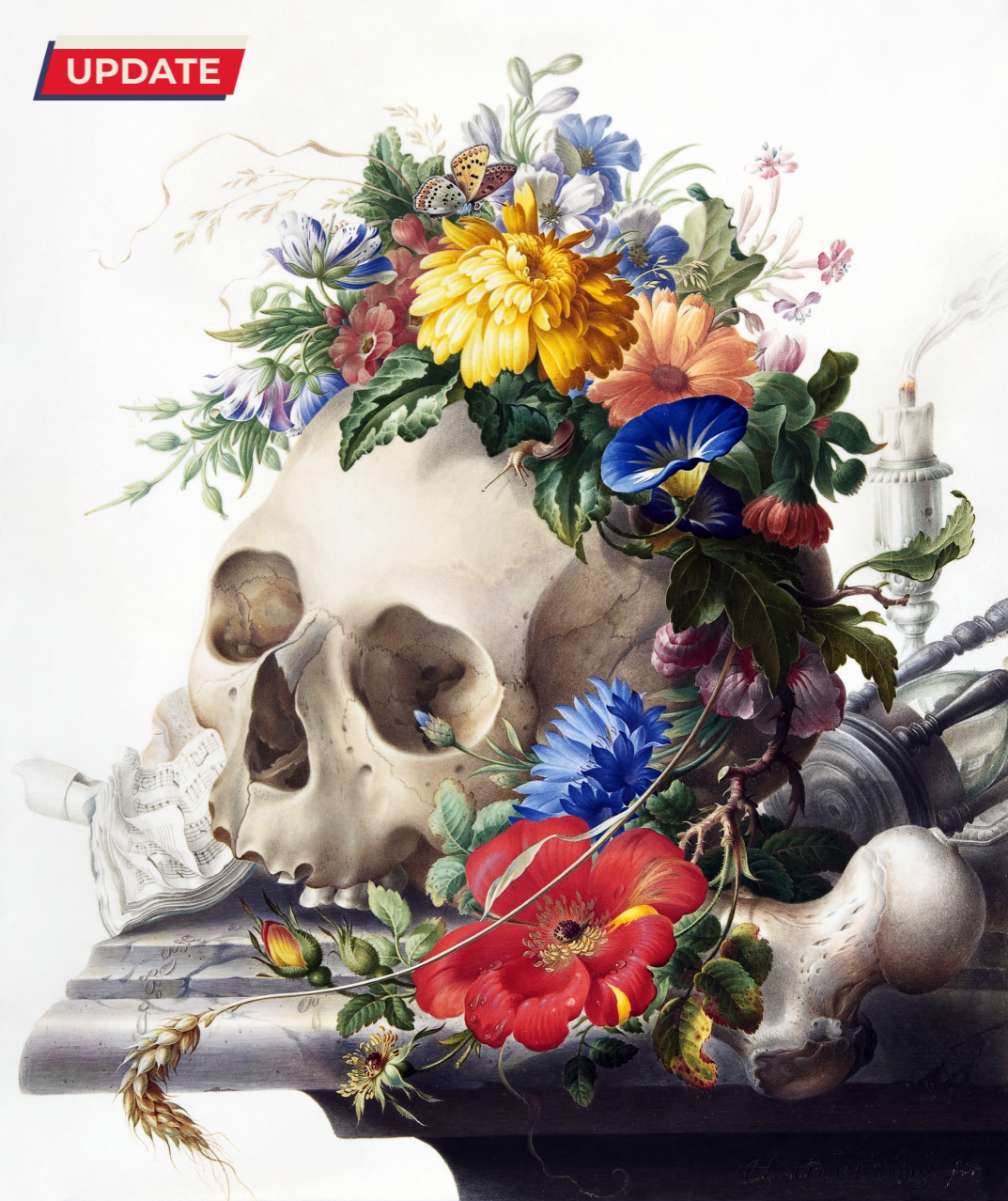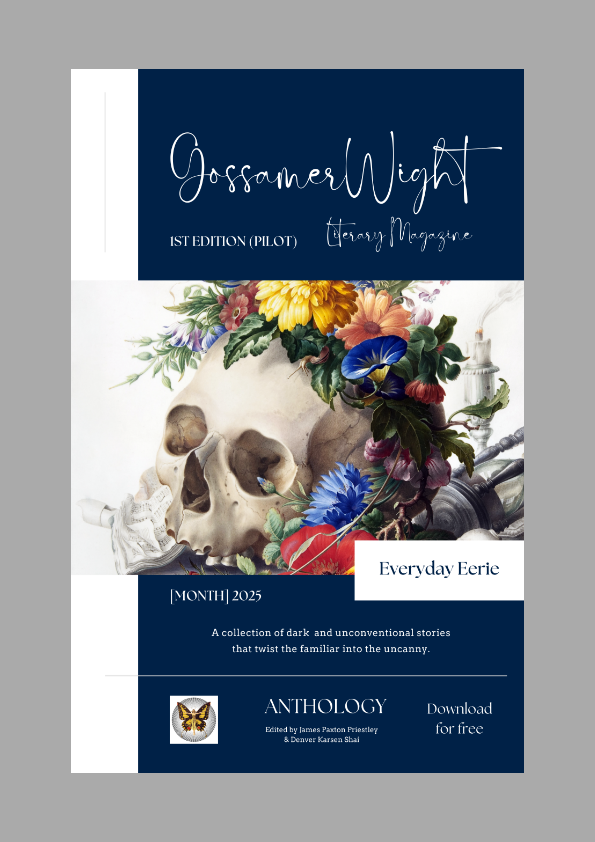
Submissions Announcement #2
The theme for the first edition (pilot) of the GossamerWight Literary Magazine Anthology is 'Everyday Eerie'.

Your story could appear in me!
The cover for GossamerWight's 1st Edition (Pilot) Anthology. The theme is 'Everyday Eerie'.
About the theme
If we were to extend the title 'Everyday Eerie' to 'Everyday Eerie–When the Ordinary Turns Otherworldly,' then it becomes easier to grasp what we are looking for. Our theme invites story submissions that all share a common thread—turning the everyday, or ordinary, into the extraordinary... or the uncanny.
In writing your story/stories, we invite you to add subversive spice; to reimagine common tropes; to gift us with a tale of the unexpected.
Our theme, 'Everyday Eerie' is:
- Broad enough to enable a spectrum of single-genre or cross-genre (mixed) submissions–be that horror (mainstream or folk); weird/New Weird; the supernatural; speculative; dystopian; or fantasy–while giving you a clear theme.
- Uncanny focused: we invite you to take a mundane setting—such as a kitchen, a commuter train, a family dinner, a suburban street, a work location, etc.—and inject a subtle, unsettling twist that makes the familiar feel off-kilter... uncanny.
For example,
The thin veil: moments when reality flickers—e.g., mirrors that reflect another world, streetlights that dim only for certain people.
Domestic dread: e.g., how everyday rituals become rites of something darker.
Hidden histories: e.g., ordinary objects that carry forgotten, malevolent legacies.
Psychological uncanny: e.g., the feeling that something is almost right, but just off enough to unsettle.
Two genre-specific submission prompts
To give you some idea of what is possible, consider these two theme-related prompts, with a cross-genre example included:
- Speculative–'The Weather Forecast That Predicts Feelings.' In a near‑future city, the meteorological service adds a new metric: 'Emotional Atmosphere,' a percentage showing collective mood. One morning, the forecast reads '30% melancholy, 20% nostalgia, 50% unease.' As commuters go about their day, subtle phenomena occur—traffic lights flicker in sync with sighs, coffee shops serve drinks that taste like long‑forgotten memories. Drop into this setting a character who tries to navigate the city while the emotional weather begins to manifest physically, turning the ordinary urban landscape into a living, uncanny organism. This would work because speculative fiction can take a mundane system (weather reports) and twist it into an uncanny force that shapes daily life.
- Dystopian–'The Compliance Mirror.' In a regime where citizens must wear 'Compliance Mirrors' that reflect their true thoughts as visual overlays, a glitch causes the mirrors to display alternate versions of reality—scenes that never happened, people who never existed, and subtle distortions of the city’s architecture. Drop into this setting a low‑level clerk who sees a version of his/her street where birds have replaced the surveillance drones, and he/she must decide whether to trust the uncanny vision or continue to obey the state’s sanctioned perception. This would work because dystopia thrives on surveillance and control; the uncanny appears when the tools of oppression betray their purpose, hinting at cracks in the system.
- Cross-genre example: speculative + fantasy. If going for a cross-genre approach, imagine expanding 'The Weather Forecast That Predicts Feelings' to include a magical aurora that physically manifests collective emotions, turning streets into living tapestries of colour and sound. Engage those senses!
General advice
Keep the word count limits in mind. Flash fiction submissions: ≤ 1,000 words. We advise that you focus on a single, sharp twist for a flash fiction piece, and establish your uncanny hook within the first 150-200 words. Short stories: ≤ 3,000 words; these can deliver a more layered world-building and character arc. In either case, your piece ought to be complete, i.e., self-contained, delivering a full story arc. To reiterate, flash fiction submissions should be up to 1,000 words, and short stories should be up to 3,000 words.
Remember, we are looking for an uncanny twist; something ordinary that looks or feels subtly 'off'–a detail that feels both familiar and off-kilter simultaneously, prompting a shiver of recognition. Ground your story first in the ordinary (the everyday) before tilting it towards the 'otherworldly.' Play with perception–let your characters question what they know; doubt always underpins the uncanny.
What next?
Monday, 22 September: the submissions window opens. We will announce opening of the submissions window in a further post and reiterate submissions guidance. The website will also email its members.
We have set the submissions window to close on All Hallows' Eve (Halloween), 31 October, but we will confirm this in our 22 September post.
To prepare for the 22 September submissions announcement, we advise those who might be interested to prepare themselves now by reading the general guidance we have provided under the Submissions tab.
A last word. Contingent on the success of our quarterly anthology releases, we envisage taking the best stories from each and combining them in an annual publication; this would be available for purchase online and in most high street bookshops.
Should you have questions, please contact the editor-in-chief using ghost.harmony854@passmail.net. Please state 'Submission query' in the subject line. Or, complete the contact form here.
With thanks,
James, Denver, and Miggy.
[Header and Anthology cover image: Vanitas still life painting by Herman Henstenburgh (1667-1726). An original public domain image from The MET Museum. Digital enhancement. Image from Rawpixel. Anthology soundtrack by DarkStreet].

